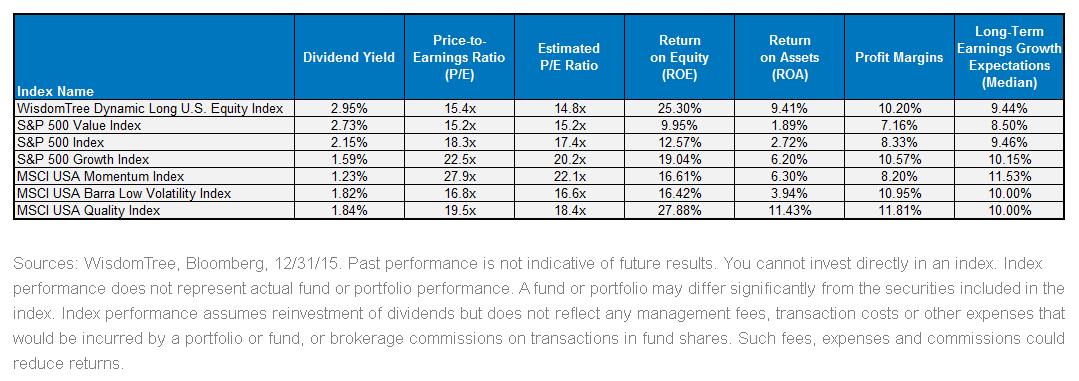Regardless of whether you believe markets are
efficient or
return premiums exist, in any given year
smart beta indexes that focus on capturing return premiums or “factors” are either going to out- or underperform
market cap-weighted indexes. Over long periods, we feel that focusing on
fundamentals and rebalancing back to those fundamentals at periodic intervals can add
value over complete market cycles, partly by tilting toward known return premiums. In 2015, value and size (i.e.,
small caps) underperformed, but momentum,
quality and low
volatility outperformed.
1
Now the question is what factors will perform best in 2016 and whether the answer changes depending on the direction of the market. WisdomTree recently created the
WisdomTree Dynamic Long/Short U.S. Equity Index (WTDLS), designed to generate
alpha at the core with a multi-factor stock selection model along with the ability to
hedge market risk dynamically.
Key Features to WisdomTree Approach
WisdomTree has been a pioneer in fundamental indexing for almost a decade, typically focusing on signal factors such as value, quality and size; but now we are pleased to introduce this new multi-factor approach. The
WisdomTree Dynamic Long U.S. Equity Index (WTDL) is the long component of WTDLS and comprises approximately 100 stocks with the highest combined fundamentals, which are low volatility weighted and rebalanced quarterly.
•
Fundamental Selection: Stocks are graded on a combination of
growth, quality and value factors, and the most attractive stocks in each sector are selected for inclusion. It is important to note that each sector has its own unique factor scoring system, because we believe a different set of fundamentals may potentially work better in one sector as opposed to another. By combining quality and value factors, which we believe complement each other, we hope to smooth the return variance in the short term, while still tapping into the long-term return premiums.
•
Low-Volatility Weighting: In each sector, the Index assigns higher weights to stocks that exhibit lower volatility characteristics, as measured by the stocks’
standard deviation and
beta to the market. We know that low volatility weighting has historically worked as a single factor, so we believe applying it to a multi-factor selection model will also add value.
•
Sector-Neutral Capping: The Index targets a sector-neutral allocation when compared to the largest 500 U.S. stocks by market capitalization. We believe this keeps the Index properly diversified and eliminates the potential for the fundamental selection or low-volatility weighting to significantly over- or under-weight certain sectors. We are confident about the stock selection and weighting process, so we wanted to rely on that to drive the relative return differentials instead of taking sector bets against a cap-weighted index.
To get a sense of the outcome from the selection and weighting process, we compared WTDL against popular market cap-weighted style and factor indexes.
Index Valuations
 For definitions of terms and indexes in the chart, visit our glossary.
For definitions of terms and indexes in the chart, visit our glossary.
•
Attractive across Multiple Valuation Measures: We find it impressive, but not surprising, that WTDL scored high on multiple valuation measures. As of 12/31/2015, WTDL had the highest
dividend yield; it also showed similar
price-to-earnings (P/E) ratios as the
S&P 500 Value Index, both indicators highlighting its tilt toward value. WTDL had the second-highest quality metrics, defined by
return on equity (ROE) and
return on assets (ROA), a very close second only to the
MSCI USA Quality Index, which focuses more directly on that factor. Lastly, WTDL had higher
profit margins than the
S&P 500 Index and very similar growth expectations.
Dynamic Hedging Indicator
The above table highlights how WTDL had diversified exposure across multiple factors—but what if markets are choppy? For one thing, the low-volatility weighting methodology could help smooth the returns and lower market
drawdowns, but a primary driver will be the dynamic hedging indicator.
The dynamic hedging indicator uses growth and quality indicators such as profit margins and popular valuation measures to determine the hedge ratio or
short percentage. So when the fundamentals, or profits, of the universe are deteriorating, the dynamic indicator would look to hedge the portfolio or increase the short percentage. Similarly, as valuations become more stretched, adding risk to the portfolio, the indicator would look to hedge as well.
While our hedging indicator will certainly not get every market downdraft timed perfectly, it did start getting more
bearishly positioned toward the end of 2015 and signaled to be 100% hedge for January 2016, making the net equity exposure for WTDLS 0% (or market neutral). We believe the factor diversity and dynamic equity exposure this index provides deserve a second look, given the recent market volatility and uncertainty for 2016.
1Sources: WisdomTree, Bloomberg, 12/31/14–12/31/15. Refers to the relative underperformance of the
MSCI USA Value (Value) and MSCI USA Small Cap (Size) and relative outperformance of MSCI USA Momentum (Momentum),
MSCI USA Quality (Quality) and MSCI USA Barra Low Volatility (Low Volatility) indexes against the MSCI USA Index.
Important Risks Related to this Article
Diversification does not eliminate the risk of experiencing investment losses.


 For definitions of terms and indexes in the chart, visit our glossary.
• Attractive across Multiple Valuation Measures: We find it impressive, but not surprising, that WTDL scored high on multiple valuation measures. As of 12/31/2015, WTDL had the highest dividend yield; it also showed similar price-to-earnings (P/E) ratios as the S&P 500 Value Index, both indicators highlighting its tilt toward value. WTDL had the second-highest quality metrics, defined by return on equity (ROE) and return on assets (ROA), a very close second only to the MSCI USA Quality Index, which focuses more directly on that factor. Lastly, WTDL had higher profit margins than the S&P 500 Index and very similar growth expectations.
Dynamic Hedging Indicator
The above table highlights how WTDL had diversified exposure across multiple factors—but what if markets are choppy? For one thing, the low-volatility weighting methodology could help smooth the returns and lower market drawdowns, but a primary driver will be the dynamic hedging indicator.
The dynamic hedging indicator uses growth and quality indicators such as profit margins and popular valuation measures to determine the hedge ratio or short percentage. So when the fundamentals, or profits, of the universe are deteriorating, the dynamic indicator would look to hedge the portfolio or increase the short percentage. Similarly, as valuations become more stretched, adding risk to the portfolio, the indicator would look to hedge as well.
While our hedging indicator will certainly not get every market downdraft timed perfectly, it did start getting more bearishly positioned toward the end of 2015 and signaled to be 100% hedge for January 2016, making the net equity exposure for WTDLS 0% (or market neutral). We believe the factor diversity and dynamic equity exposure this index provides deserve a second look, given the recent market volatility and uncertainty for 2016.
1Sources: WisdomTree, Bloomberg, 12/31/14–12/31/15. Refers to the relative underperformance of the MSCI USA Value (Value) and MSCI USA Small Cap (Size) and relative outperformance of MSCI USA Momentum (Momentum), MSCI USA Quality (Quality) and MSCI USA Barra Low Volatility (Low Volatility) indexes against the MSCI USA Index.
For definitions of terms and indexes in the chart, visit our glossary.
• Attractive across Multiple Valuation Measures: We find it impressive, but not surprising, that WTDL scored high on multiple valuation measures. As of 12/31/2015, WTDL had the highest dividend yield; it also showed similar price-to-earnings (P/E) ratios as the S&P 500 Value Index, both indicators highlighting its tilt toward value. WTDL had the second-highest quality metrics, defined by return on equity (ROE) and return on assets (ROA), a very close second only to the MSCI USA Quality Index, which focuses more directly on that factor. Lastly, WTDL had higher profit margins than the S&P 500 Index and very similar growth expectations.
Dynamic Hedging Indicator
The above table highlights how WTDL had diversified exposure across multiple factors—but what if markets are choppy? For one thing, the low-volatility weighting methodology could help smooth the returns and lower market drawdowns, but a primary driver will be the dynamic hedging indicator.
The dynamic hedging indicator uses growth and quality indicators such as profit margins and popular valuation measures to determine the hedge ratio or short percentage. So when the fundamentals, or profits, of the universe are deteriorating, the dynamic indicator would look to hedge the portfolio or increase the short percentage. Similarly, as valuations become more stretched, adding risk to the portfolio, the indicator would look to hedge as well.
While our hedging indicator will certainly not get every market downdraft timed perfectly, it did start getting more bearishly positioned toward the end of 2015 and signaled to be 100% hedge for January 2016, making the net equity exposure for WTDLS 0% (or market neutral). We believe the factor diversity and dynamic equity exposure this index provides deserve a second look, given the recent market volatility and uncertainty for 2016.
1Sources: WisdomTree, Bloomberg, 12/31/14–12/31/15. Refers to the relative underperformance of the MSCI USA Value (Value) and MSCI USA Small Cap (Size) and relative outperformance of MSCI USA Momentum (Momentum), MSCI USA Quality (Quality) and MSCI USA Barra Low Volatility (Low Volatility) indexes against the MSCI USA Index.


